We may not have the course you’re looking for. If you enquire or give us a call on +44 1344 203 999 and speak to our training experts, we may still be able to help with your training requirements.
Training Outcomes Within Your Budget!
We ensure quality, budget-alignment, and timely delivery by our expert instructors.
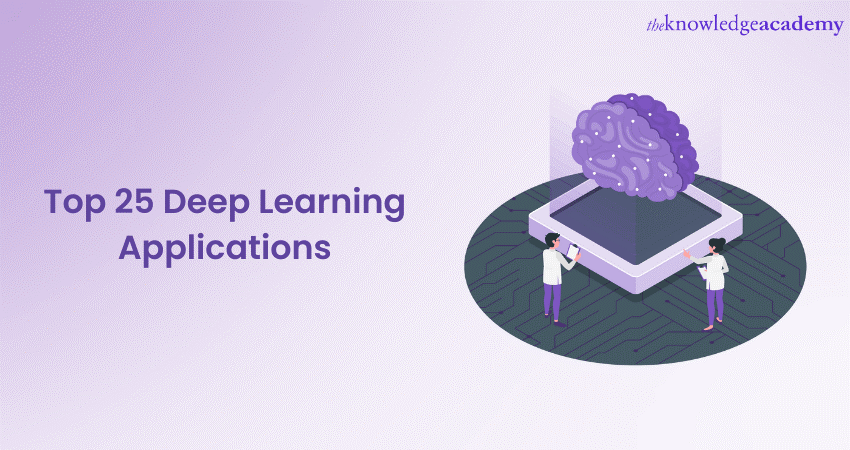
Deep Learning (DL) invokes a complexity similar to the human mind as it powers everything from smartphones' facial recognition to life-saving medical insights. Deep Learning Applications have undergone a meteoric rise, varying from mere algorithmic curiosities to the bedrock of modern innovation. As the world reflects on this evolution, you probably can't help but marvel at how its growth has transformed the digital landscape over time.
According to Statista, the Deep Learning market is expected to grow up to 15.75 billion GBP by the year 2027. This reflects on the increasing rate at which DL is prominent in everyday life. If you wish to learn more about the various applications of Deep Learning, you have found the right blog. Check out the list of top 25 Deep Learning Applications which are used in various sectors such as Speech Synthesis, Language Translation, and more.
Table of Contents
1) Deep Learning Applications in technology
2) Deep Learning Applications in healthcare
3) Deep Learning Applications in finance
4) Deep Learning Applications in environment and urban planning
5) Conclusion
Deep Learning Applications in technology
In today's digital age, technology and communication go hand-in-hand. This category encompasses Deep Learning Applications in AI that enhance our interaction with devices, streamline communication, and provide seamless user experiences. From intuitive voice-activated assistants to sophisticated handwriting recognition, Deep Learning propels the evolution of smart communication tools. Some examples of Deep Learning in technology are as follows:
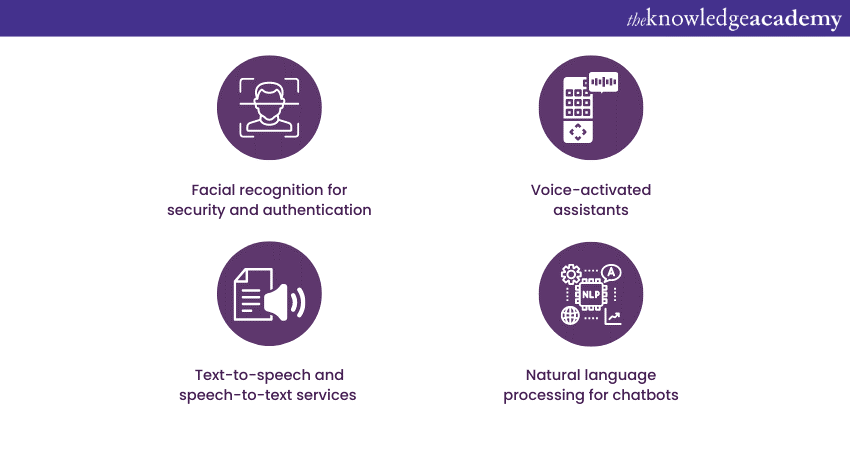
1) Facial recognition for security and authentication
Facial recognition technology, empowered by Deep Learning, has witnessed substantial advancements over recent times. It meticulously analyses patterns and intricacies in facial features, enabling swift and precise identification and verification of individuals. As the algorithms have matured and been trained on extensive datasets, the accuracy of these recognition systems has seen remarkable improvement.
The evolution of facial recognition has cemented facial recognition's role as a vital tool across a spectrum of sectors and applications. The convenience of instantly unlocking smartphones with a mere glance, heightened security protocols for access to secure buildings, and the automated tagging of friends and family in photographs on platforms such as Facebook all underscore the pervasive impact of this technology. Beyond mere convenience, facial recognition significantly bolsters security measures and personalises user experiences across the digital realm.
2) Voice-activated assistants
Voice-activated assistants, exemplified by well-known names such as Siri or Alexa, leverage the power of Deep Learning to interpret and process spoken instructions from users. These assistants dissect the nuances of human speech, translating the instructions into specific tasks, and subsequently generating the most suitable response or carrying out the desired action.
The underlying algorithms learn progressively; as they accumulate more data from continuous user interactions, they undergo refinements in their comprehension of voice patterns, tones, and contexts. This iterative learning process gradually enhances their accuracy and responsiveness. Over time, these voice-activated assistants have woven themselves into the fabric of our daily lives.
The use cases of voice assistant vary from simple task of setting alarms to start our day, invoking them to serenade us with our favourite tunes, or seeking real-time updates about impending rain or sunshine, these intelligent assistants have transformed the way we interact with technology, making it more intuitive, personalised, and accessible than ever before.
3) Text-to-speech and speech-to-text services
Deep Learning plays a pivotal role in these services. Text-to-speech technology converts written text into audible speech, enabling a host of applications, from aiding visually impaired individuals to making content more accessible. Conversely, speech-to-text services transcribe spoken words into text, facilitating real-time subtitles, transcription services, and voice command processing.
4) Natural language processing for chatbots
Chatbots have transformed customer service and support. Leveraging natural language processing (NLP) — a subset of Deep Learning focused on the interaction between computers and human language — chatbots can understand, interpret, and respond to user queries, making them seem almost human. They're present everywhere, from website pop-ups assisting online shoppers to support chat boxes troubleshooting technical issues.
Try our course in Introduction to Artificial Intelligence Training today!
5) Predictive text and smart replies in communication apps
Anyone who has sent a text from a smartphone has likely encountered predictive text. Predictive text and smart replies are pivotal in modern communication apps, enhanced by Deep Learning. Predictive text anticipates a user's next word, making typing faster and more intuitive. Meanwhile, smart replies offer instant, context-based responses to incoming messages. Both features exemplify how artificial intelligence streamlines and enriches our daily digital interactions.
6) Virtual reality (VR) and Augmented Reality (AR) enhancements
The immersive environments of VR and the superimposed digital data of AR both benefit immensely from Deep Learning. Virtual Reality, which crafts entirely artificial environments, is now more adaptable and intuitive than ever. For instance, a VR game can alter its storyline based on the decisions and movements of the player, offering a genuinely personalised experience. This adaptability, powered by Deep Learning, ensures users find themselves in an environment that's continuously evolving in reaction to their input.
7) Handwriting recognition and conversion
Handwriting recognition and conversion stands as a testament to the prowess of Deep Learning. Given the vast variations in individual handwriting styles, it's remarkable how algorithms can now accurately discern and transform them into digital format. This innovation proves invaluable in various domains: turning scribbled notes into digitised content, facilitating banking processes by reading handwritten cheques, or unravelling the mysteries in ancient handwritten documents.
8) Game character design
Deep Learning is reshaping the realm of video games, particularly in character design and behaviour. Through algorithms, developers can auto-generate detailed and diverse character designs, enriching the gaming universe. But the revolution doesn't stop at mere appearances. Deep Learning also refines non-player character (NPC) behaviour. By analysing myriad player decisions, these algorithms modify NPC reactions in real-time, offering more authentic and unpredictable responses. This fusion of design and dynamic behaviour ensures that players engage with a game world that's immersive, reactive, and eerily close to the complexities of the real world.
Interested in machines and AI? Unleash their potential Machine Learning Training today!
Deep Learning Applications in healthcare
The intersection of Deep Learning with healthcare and life sciences holds the promise of transformative breakthroughs. Whether it's identifying diseases with higher accuracy or pioneering drug discoveries, these applications optimise and innovate medical practices. Moreover, the therapeutic potential of AI-driven music generation offers a glimpse into future wellness strategies. Here are Some Deep Learning Applications examples in context of healthcare:
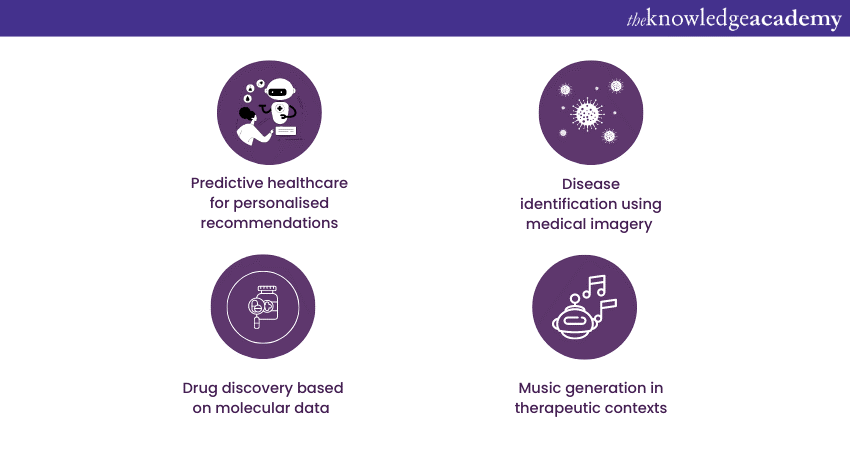
9) Predictive healthcare for personalised recommendations
In the modern healthcare landscape, a one-size-fits-all approach no longer suffices. Enter predictive healthcare, a Deep Learning-driven marvel. By meticulously sifting through individual health records and continuously updating data streams, this technology offers bespoke health recommendations tailored to each patient. The power of such personalised insights cannot be overstated: it not only enhances patient care and wellness but also anticipates and wards off potential health issues, fundamentally transforming the healthcare journey.
10) Disease identification using medical imagery
The rapid advancements in medical imaging technologies, combined with the prowess of Deep Learning, have ushered in a new era of diagnostics. Rather than relying solely on human interpretation, algorithms now scrutinise medical images, such as MRIs or X-rays, with astonishing precision.
These Deep Learning models can detect minute irregularities often missed by the human eye, facilitating quicker and more accurate disease diagnoses. The implications are profound: timely interventions, more effective treatment plans, and significantly improved patient outcomes.
11) Drug discovery based on molecular data
The labyrinthine world of drug discovery has historically been both time-consuming and financially draining. However, the infusion of Deep Learning into this realm is proving transformative.
Sifting through vast datasets of molecular structures and interactions allows these advanced algorithms to predict the therapeutic potential of compounds with speed and accuracy hitherto deemed unattainable. The result? A significantly accelerated drug development pipeline, reducing costs, and more importantly, delivering life-saving treatments to patients in a fraction of the conventional time.
12) Music generation in therapeutic contexts
Music, with its profound impact on the human psyche, has long been a therapeutic tool. Deep Learning has carved a niche here too, enhancing therapeutic music generation. Processing and interpreting listener feedback and emotional responses, algorithms craft compositions tailored for therapeutic intents such as relaxation
Music generated through AI can also help in emotional processing and cognitive improvement. The convergence of art and technology in this manner heralds a fresh wave of therapeutic interventions, blending ancient wisdom with cutting-edge innovation.
Learn about smart machines with our Artificial Intelligence & Machine Learning Courses!
Deep Learning Applications in finance
Deep Learning’s foray into finance and commerce has reshaped these sectors dramatically. By detecting fraudulent activities or predicting stock market trends, AI safeguards our financial assets. Additionally, in commerce, whether it's tailoring content recommendations or reinventing search methodologies, Deep Learning enhances consumer experiences in unprecedented ways. Some examples of Deep Learning Applications in finance are as follows:
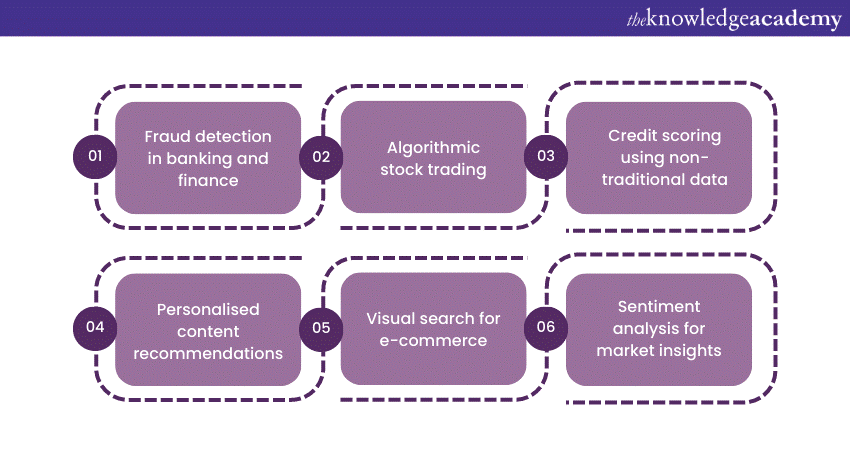
13) Fraud detection in banking and finance
The financial world, while bustling with transactions, is also rife with potential frauds. Banks and financial institutions now leverage Deep Learning to detect suspicious patterns. By analysing vast swaths of transaction data in real-time, these algorithms can pinpoint anomalies that might indicate fraudulent activity. The result? Enhanced security, immediate red flags, and a significant reduction in financial losses.
14) Algorithmic stock trading
The stock market's unpredictable nature has always been a challenge for traders. Enter algorithmic stock trading powered by Deep Learning. These algorithms sift through vast datasets, considering market trends, global news, and intricate financial indicators to make informed buying or selling decisions in fractions of a second. Their ability to process information rapidly and act instantaneously grants them an edge in the ever-fluctuating stock market landscape.
15) Credit scoring using non-traditional data
Traditional credit scoring methods often miss out on capturing the complete financial profile of individuals. Deep Learning steps in to fill this void. By considering non-traditional data sources — from online purchase histories to social media behaviour — these algorithms offer a more holistic view of an individual's creditworthiness. This ensures more inclusive financial systems and better-informed lending decisions.
16) Personalised content recommendations
Ever wondered how streaming giants like Netflix or Spotify seem to know your preferences intimately? Deep Learning is the secret. By analysing your watch or listen history, these platforms predict what you might enjoy next, tailoring recommendations specifically for you. This ensures not only increased user engagement but also a personalised entertainment experience for every user.
17) Visual search for e-commerce
E-commerce platforms are increasingly embracing visual search, making shopping more intuitive. You can even snap a photo of a desired item, and Deep Learning algorithms will scour the web or specific platforms to find similar products. Eliminating the need for textual descriptions and understanding visual nuances, allow these platforms to offer a more seamless and efficient shopping experience.
18) Sentiment analysis for market insights
Brands and businesses thrive on understanding consumer sentiment. Deep Learning aids in this endeavour by processing vast quantities of online conversations, reviews, and comments. Through sentiment analysis, businesses can gauge public sentiment towards products, campaigns, or services, offering valuable insights for refining strategies and enhancing consumer relations.
Learn everything about neural networks with our Deep Learning Training today!
Deep Learning Applications in environment and urban planning
A sustainable future hinges on our ability to harness technology for agriculture, environmental conservation, and urban planning. Deep Learning assists in everything from monitoring crop health via drones to predicting urban traffic patterns. These applications not only ensure efficient resource use but also pave the way for environmentally conscious innovations. Some examples of Deep Learning Applications in environment and urban planning are as follows:
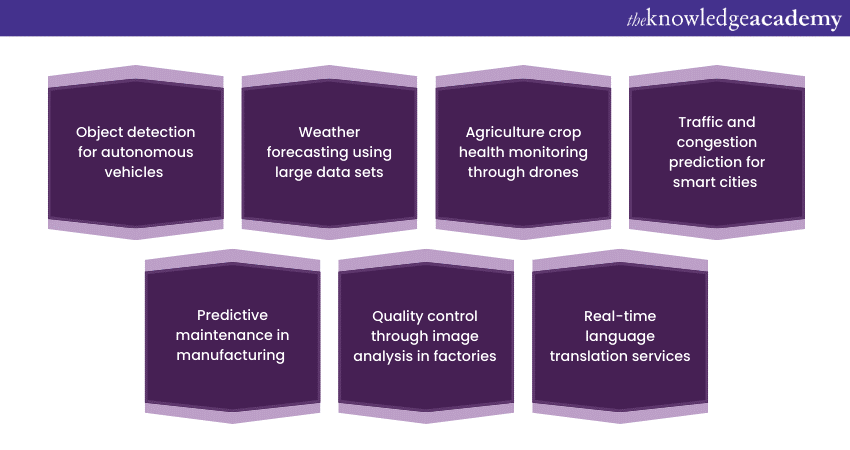
19) Object detection for autonomous vehicles
The surge of autonomous vehicles on our streets owes a great deal to Deep Learning. With the mission of ensuring safety, these vehicles deploy sophisticated object detection systems. Through continuous analysis of high-definition imagery from multiple sensors and cameras, Deep Learning algorithms discern pedestrians, vehicles, and obstacles in real-time. These intelligent systems make rapid decisions, allowing for efficient navigation, especially in dense urban environments, setting the cornerstone for the future of autonomous transportation.
20) Weather forecasting using large data sets
Deep Learning is revolutionising meteorology. Delving into vast data sets like satellite images and ocean temperature readings allows these algorithms to provide meteorologists with incredibly accurate short and long-term weather predictions. Such precision not only aids our daily planning but is invaluable for industries dependent on weather conditions. As climate change have resulted in unpredictable weather patterns, these sophisticated forecasting tools become even more essential.
21) Agriculture crop health monitoring through drones
Modern agriculture intertwines with technology to maximise productivity. Equipped with cameras and Deep Learning systems, drones are becoming farmers' eyes in the sky. As they traverse fields, they assess crop health, detect diseases, and monitor hydration levels. This aerial intelligence provides farmers with valuable insights, helping them make informed decisions about irrigation, pesticide use, and harvesting times. As a result, yields are maximised, and resources are optimally utilised.
22) Traffic and congestion prediction for smart cities
As cities expand and populations swell, urban congestion becomes a pressing issue. Smart cities, empowered by Deep Learning, are pioneering solutions. By analysing vast amounts of data, from vehicular flow to public events, these algorithms can accurately predict congestion hotspots. City planners and residents get foresight into traffic conditions, enabling better routing, infrastructure planning, and public transport management. The end goal? Fluid, efficient urban mobility.
23) Predictive maintenance in manufacturing
In the manufacturing arena, equipment downtime can lead to significant losses. Deep Learning comes to the rescue with predictive maintenance. By continuously monitoring machinery for subtle changes in performance, noise, or vibration, these systems can anticipate potential breakdowns. This foresight allows for timely maintenance, ensuring that production lines remain uninterrupted, costs are saved, and the overall lifecycle of equipment is extended.
24) Quality control through image analysis in factories
Quality assurance is the backbone of manufacturing. Here, Deep Learning shines brightly. High-resolution cameras, combined with sophisticated image analysis algorithms, meticulously inspect products on assembly lines. Even the slightest deviations or defects are caught, many of which might elude human inspectors. This ensures products meet stringent quality standards, reinforcing brand integrity and customer trust.
25) Real-time language translation services
In an era of global dialogue on environmental challenges, Deep Learning bridges linguistic divides. At international conferences or summits, real-time translation services, powered by these algorithms, ensure that communication is seamless. Delegates can share insights, research, and solutions in their native tongues, confident that their messages will resonate universally. In breaking down language barriers, Deep Learning fosters collaboration and a shared commitment to our planet's future.
Conclusion
Deep Learning Applications are profoundly shaping our digital landscape. From simplifying daily tasks to revolutionising healthcare, its influence is undeniable. As the technology progresses, its presence in our lives will only deepen. So, when streaming a film or using a voice assistant, remember the advanced Deep Learning algorithms enhancing your experience behind the scenes.
Interested in neural networks? Try our Neural Networks With Deep Learning Training!
Frequently Asked Questions
Upcoming Data, Analytics & AI Resources Batches & Dates
Date
 Introduction to AI Course
Introduction to AI Course
Fri 15th Nov 2024
Fri 17th Jan 2025
Fri 7th Mar 2025
Fri 23rd May 2025
Fri 18th Jul 2025
Fri 12th Sep 2025
Fri 14th Nov 2025
Fri 12th Dec 2025







 Top Rated Course
Top Rated Course



 If you wish to make any changes to your course, please
If you wish to make any changes to your course, please


